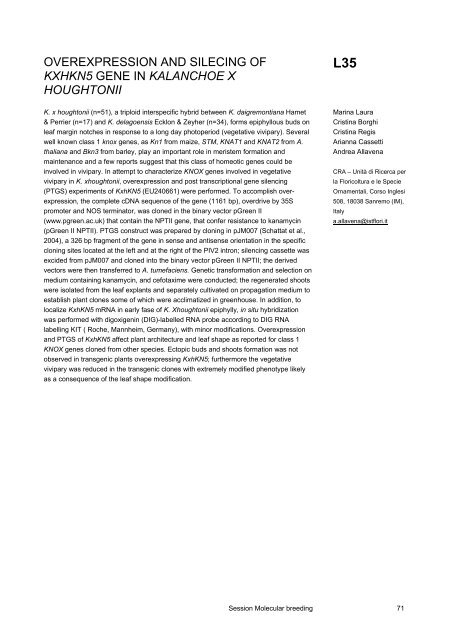XXIIIrd International Eucarpia symposium, Section Ornamentals ...
XXIIIrd International Eucarpia symposium, Section Ornamentals ...
XXIIIrd International Eucarpia symposium, Section Ornamentals ...
Create successful ePaper yourself
Turn your PDF publications into a flip-book with our unique Google optimized e-Paper software.
OVEREXPRESSION AND SILECING OF<br />
KXHKN5 GENE IN KALANCHOE X<br />
HOUGHTONII<br />
K. x houghtonii (n=51), a triploid interspecific hybrid between K. daigremontiana Hamet<br />
& Perrier (n=17) and K. delagoensis Ecklon & Zeyher (n=34), forms epiphyllous buds on<br />
leaf margin notches in response to a long day photoperiod (vegetative vivipary). Several<br />
well known class 1 knox genes, as Kn1 from maize, STM, KNAT1 and KNAT2 from A.<br />
thaliana and Bkn3 from barley, play an important role in meristem formation and<br />
maintenance and a few reports suggest that this class of homeotic genes could be<br />
involved in vivipary. In attempt to characterize KNOX genes involved in vegetative<br />
vivipary in K. xhoughtonii, overexpression and post transcriptional gene silencing<br />
(PTGS) experiments of KxhKN5 (EU240661) were performed. To accomplish overexpression,<br />
the complete cDNA sequence of the gene (1161 bp), overdrive by 35S<br />
promoter and NOS terminator, was cloned in the binary vector pGreen II<br />
(www.pgreen.ac.uk) that contain the NPTII gene, that confer resistance to kanamycin<br />
(pGreen II NPTII). PTGS construct was prepared by cloning in pJM007 (Schattat et al.,<br />
2004), a 326 bp fragment of the gene in sense and antisense orientation in the specific<br />
cloning sites located at the left and at the right of the PIV2 intron; silencing cassette was<br />
excided from pJM007 and cloned into the binary vector pGreen II NPTII; the derived<br />
vectors were then transferred to A. tumefaciens. Genetic transformation and selection on<br />
medium containing kanamycin, and cefotaxime were conducted; the regenerated shoots<br />
were isolated from the leaf explants and separately cultivated on propagation medium to<br />
establish plant clones some of which were acclimatized in greenhouse. In addition, to<br />
localize KxhKN5 mRNA in early fase of K. Xhoughtonii epiphylly, in situ hybridization<br />
was performed with digoxigenin (DIG)-labelled RNA probe according to DIG RNA<br />
labelling KIT ( Roche, Mannheim, Germany), with minor modifications. Overexpression<br />
and PTGS of KxhKN5 affect plant architecture and leaf shape as reported for class 1<br />
KNOX genes cloned from other species. Ectopic buds and shoots formation was not<br />
observed in transgenic plants overexpressing KxhKN5; furthermore the vegetative<br />
vivipary was reduced in the transgenic clones with extremely modified phenotype likely<br />
as a consequence of the leaf shape modification.<br />
L35<br />
Marina Laura<br />
Cristina Borghi<br />
Cristina Regis<br />
Arianna Cassetti<br />
Andrea Allavena<br />
CRA – Unità di Ricerca per<br />
la Floricoltura e le Specie<br />
Ornamentali, Corso Inglesi<br />
508, 18038 Sanremo (IM),<br />
Italy<br />
a.allavena@istflori.it<br />
Session Molecular breeding 71














